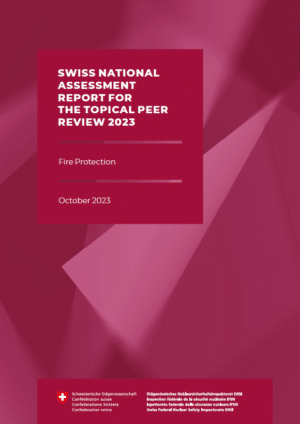Fire Protection in Nuclear Installations: Swiss National Report Submitted to ENSREG
Swiss nuclear installations comply with WENRA’s fire protection requirements. This is the conclusion that ENSI has reached within the framework of the Topical Peer Review 2023. This European review was instigated by ENSREG.
Switzerland submitted its National Report on Fire Protection in Nuclear Installations to the European Nuclear Safety Regulators Group (ENSREG) as part of the Topical Peer Review 2023. In the National Report, the Swiss Federal Nuclear Safety Inspectorate (ENSI) assesses both the fire protection measures and fire analyses carried out to check the fire protection in Swiss nuclear power plants and interim storage facilities. The assessment criteria are based on the fire safety requirements for nuclear installations as defined by the Western European Nuclear Regulators Association (WENRA).
WENRA
WENRA was founded in 1999 as a network of Western European regulators. The association aims to harmonise and improve safety in matters relating to the operation and decommissioning of nuclear power stations and to the management of radioactive waste in Europe. WENRA has no formal status – cooperation within it is purely voluntary. Nevertheless, WENRA members undertake to implement WENRA safety reference levels in their respective national regulations. Members are the regulatory authorities from 18 currently or formerly nuclear-operating states in the EU, as well as from the UK, Switzerland and Ukraine.
For nuclear safety: Effective measures in the event of a fire
In the National Report, ENSI concludes that the basic concept of defence-in-depth fire protection provision is consistently being pursued in all Swiss nuclear installations. The concept includes both the prevention and control of fires as well as reducing the consequences of fires. The necessary protection measures are documented in the installation-specific fire protection concepts.
The fire analyses show that thanks to the protection measures in place in the Swiss nuclear installations, any possible release of radioactive substances in a fire remains well below the regulatory requirements.
From ENSI’s point of view, the implementation of the latest state-of-the-art fire protection technology in the nuclear installations, some of which are more than 50 years old, presents a particular challenge. The Report identified a need to update fire protection concepts in some nuclear installations. ENSI has also recognised that the scope of fire protection inspections needs to be increased.
These principles of fire protection are being implemented across all Swiss nuclear installations
- The installations each have a fire protection policy that includes the most important fire protection principles. The associated documentation is regularly reviewed and adapted.
- In the installations, any fire loads present, i.e. all combustible materials, are systematically recorded. Materials that are installed in the buildings (fixed fire loads) as well as materials located or stored in the buildings (mobile fire loads) are evaluated.
- Buildings are fully monitored using fire detection systems in accordance with national fire protection regulations. In recent years, fire detection systems have either been upgraded to the latest state of the art or are currently being upgraded.
- The functioning of the fire protection equipment is regularly checked in the installations.
- In accordance with national fire protection regulations, the installations are divided into fire compartments.
- In each of the installations, should a fire break out, fire dampers are closed in a targeted manner to isolate fire compartments and limit the spreading of fire.
- The fire safety officers are fully trained in their function.
Review of the National Report
As part of the Topical Peer Review 2023, the review of fire protection in nuclear installations takes place in three steps. In a first step, all participating countries evaluate the fire protection measures in their nuclear installations and summarise the results in a National Report. In a second step, fire protection experts from the participating countries assess the National Reports and derive recommendations from them, which are incorporated into national action plans in the third step.
What is the origin of the topical peer review?
After the reactor disaster in Fukushima, all nuclear power plants in the European Union, Switzerland and the Ukraine underwent a stress test in 2011. The reports were then reviewed by international experts and published.
In 2014 the Council of the European Union updated the EU Nuclear Safety Directive for the safety of nuclear installations. Amongst other things this envisages so-called Topical Peer Reviews for nuclear installations, a process in which partner countries review a particular key topic. Every six years the focus will be on a different aspect of the technical safety of nuclear installations.
The first Topical Peer Review 2017 focused on ageing management in nuclear power plants.


